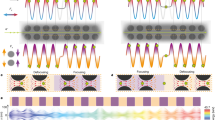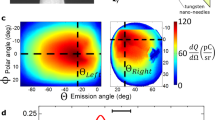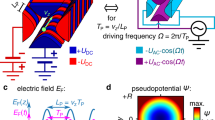Abstract
Particle accelerators are essential tools in science, hospitals and industry1,2,3,4,5,6. Yet their costs and large footprint, ranging in length from metres to several kilometres, limit their use. The recently demonstrated nanophotonics-based acceleration of charged particles can reduce the cost and size of these accelerators by orders of magnitude7,8,9. In this approach, a carefully designed nanostructure transfers energy from laser light to the particles in a phase-synchronous manner, accelerating them. To accelerate particles to the megaelectronvolt range and beyond, with minimal particle loss10,11, the particle beam needs to be confined over extended distances, but the necessary control of the electron beam’s phase space has been elusive. Here we demonstrate complex electron phase-space control at optical frequencies in the 225-nanometre narrow channel of a silicon-based photonic nanostructure that is 77.7 micrometres long. In particular, we experimentally show alternating phase focusing10,11,12,13, a particle propagation scheme for minimal-loss transport that could, in principle, be arbitrarily long. We expect this work to enable megaelectronvolt electron-beam generation on a photonic chip, with potential for applications in radiotherapy and compact light sources9, and other forms of electron phase-space control resulting in narrow energy or zeptosecond-bunched beams14,15,16.
This is a preview of subscription content, access via your institution
Access options
Access Nature and 54 other Nature Portfolio journals
Get Nature+, our best-value online-access subscription
$29.99 / 30 days
cancel any time
Subscribe to this journal
Receive 51 print issues and online access
$199.00 per year
only $3.90 per issue
Buy this article
- Purchase on Springer Link
- Instant access to full article PDF
Prices may be subject to local taxes which are calculated during checkout




Similar content being viewed by others
Data availability
Source data for Fig. 4a, c are provided with the paper. The data in Fig. 4b, d that support the findings of this study are available in Zenodo with the identifier https://doi.org/10.5281/zenodo.4446542. Source data are provided with this paper.
Change history
27 January 2022
In the version of this article initially published, there was an error in the ordering of the Extended Data Figures. The image order has been amended.
References
Aad, G. et al. A particle consistent with the Higgs boson observed with the ATLAS detector at the large hadron collider. Science 338, 1576–1582 (2012).
Chatrchyan, S. et al. A new boson with a mass of 125 GeV observed with the CMS experiment at the large hadron collider. Science 338, 1569–1575 (2012).
Focus: Synchrotron techniques. Nat. Rev. Mater. https://www.nature.com/collections/vjzmtcbvzy (2018).
Bucksbaum, P., Möller, T. & Ueda, K. Frontiers of free-electron laser science. J. Phys. At. Mol. Opt. Phys. 46, 160201 (2013).
Karzmark, C. J. Advances in linear accelerator design for radiotherapy. Med. Phys. 11, 105–128 (1984).
Podgorsak, E. B. Radiation Oncology Physics: A Handbook for Teachers and Students (International Atomic Energy Agency, 2005).
Breuer, J. & Hommelhoff, P. Laser-based acceleration of nonrelativistic electrons at a dielectric structure. Phys. Rev. Lett. 111, 134803 (2013).
Peralta, E. A. et al. Demonstration of electron acceleration in a laser-driven dielectric microstructure. Nature 503, 91–94 (2013).
England, R. J. et al. Dielectric laser accelerators. Rev. Mod. Phys. 86, 1337–1389 (2014).
Wangler, T. P. RF Linear Accelerators 2nd edition (Wiley-VCH, 2008).
Chao, A. W., Mess, K. H., Tigner, M. & Zimmermann, F. Handbook of Accelerator Physics and Engineering 2nd edition (2013).
Courant, E. D. & Snyder, H. S. Theory of the alternating-gradient synchrotron. Ann. Phys. 3, 1–48 (1958).
Niedermayer, U., Egenolf, T., Boine-Frankenheim, O. & Hommelhoff, P. Alternating-phase focusing for dielectric-laser acceleration. Phys. Rev. Lett. 121, 214801 (2018).
Schönenberger, N. et al. Generation and characterization of attosecond microbunched electron pulse trains via dielectric laser acceleration. Phys. Rev. Lett. 123, 264803 (2019).
Black, D. S. et al. Net acceleration and direct measurement of attosecond electron pulses in a silicon dielectric laser accelerator. Phys. Rev. Lett. 123, 264802 (2019).
Niedermayer, U. et al. Low-energy-spread attosecond bunching and coherent electron acceleration in dielectric nanostructures. Phys. Rev. Appl. 15, L021002 (2021).
Panofsky, W. K. H. & Wenzel, W. A. Some considerations concerning the transverse deflection of charged particles in radio-frequency fields. Rev. Sci. Instrum. 27, 967 (1956).
Shimoda, K. Proposal for an electron accelerator using an optical maser. Appl. Opt. 1, 33–35 (1962).
Lohmann, A. Electron acceleration by light waves. IBM Tech. Note 5, 169–182 (1962).
Cesar, D. et al. High-field nonlinear optical response and phase control in a dielectric laser accelerator. Commun. Phys. 1, 46 (2018).
Leedle, K. J., Fabian Pease, R., Byer, R. L. & Harris, J. S. Laser acceleration and deflection of 96.3 keV electrons with a silicon dielectric structure. Optica 2, 158–161 (2015).
Kozák, M. et al. Optical gating and streaking of free electrons with sub-optical cycle precision. Nat. Commun. 8, 14342 (2017).
Leedle, K. J. et al. Phase-dependent laser acceleration of electrons with symmetrically driven silicon dual pillar gratings. Opt. Lett. 43, 2181 (2018).
McNeur, J. et al. Elements of a dielectric laser accelerator. Optica 5, 687–690 (2018).
Black, D. S. et al. Laser-driven electron lensing in silicon microstructures. Phys. Rev. Lett. 122, 104801 (2019).
Sapra, N. V. et al. On-chip integrated laser-driven particle accelerator. Science 367, 79–83 (2020).
Shiltsev, V. & Zimmermann, F. Modern and future colliders. Rev. Mod. Phys. 93, 015006 (2021).
Naranjo, B., Valloni, A., Putterman, S. & Rosenzweig, J. B. Stable charged-particle acceleration and focusing in a laser accelerator using spatial harmonics. Phys. Rev. Lett. 109, 164803 (2012).
Niedermayer, U., Egenolf, T. & Boine-Frankenheim, O. Three dimensional alternating-phase focusing for dielectric-laser electron accelerators. Phys. Rev. Lett. 125, 164801 (2020).
Kozák, M. et al. Ultrafast scanning electron microscope applied for studying the interaction between free electrons and optical near-fields of periodic nanostructures. J. Appl. Phys. 124, 023104 (2018).
Yousefi, P. et al. Dielectric laser electron acceleration in a dual pillar grating with a distributed Bragg reflector. Opt. Lett. 44, 1520 (2019).
Roques-Carmes, C. et al. Towards integrated tunable all-silicon free-electron light sources. Nat. Commun. 10, 3176 (2019).
Wiedemann, H. Particle Accelerator Physics (Springer, 2015).
Hirano, T. et al. A compact electron source for the dielectric laser accelerator. Appl. Phys. Lett. (2020).
Zhao, Z. et al. Design of a multichannel photonic crystal dielectric laser accelerator. Photon. Res. 8, 1586–1598 (2020).
Staude, I. et al. Waveguides in three-dimensional photonic bandgap materials for particle-accelerator on a chip architectures. Opt. Express 20, 5607–5612 (2012).
Egenolf, T., Niedermayer, U. & Boine-Frankenheim, O. Tracking with wakefields in dielectric laser acceleration grating structures. Phys. Rev. Accel. Beams 23, 054402 (2020). 0987654321``
Kimura, W. D., Poaorelsky, I. V & Schächter, L. CO2-laser-driven dielectric laser accelerator. In 2018 IEEE Advanced Accelerator Concepts Workshop (AAC) https://doi.org/10.1109/AAC.2018.8659403 (2018).
Egerton, R. F. Outrun radiation damage with electrons? Adv. Struct. Chem. Imaging 1, 5 (2015).
Cros, B. & Muggli, P. Input to the European Particle Physics Strategy Update. in Advanced Linear Collider Study Group (ALEGRO collaboration) (2018).
Brüning, O. S. et al. LHC Design Report CERN-2004-003-V-1 (2004).
Acknowledgements
We acknowledge discussions with the members of the Accelerator on a Chip International Program (ACHIP). We thank the clean-room facility staff at the Max Planck Institute for the Science of Light for continued assistance. We acknowledge funding by the Gordon and Betty Moore Foundation (#GBMF4744), ERC grants NearFieldAtto (#616823) and AccelOnChip (#884217) and BMBF projects 05K19WEB and 05K19RDE.
Author information
Authors and Affiliations
Contributions
T.C. and J.I. measured the data. R.S. and U.N. designed the structures and performed simulations. P.Y. fabricated the structures. J.I., R.S. and T.C. analysed the data. N.S. and A.M. inferred stringent tolerance requirements from initial measurements. J.I., R.S. and P.H. wrote the manuscript. P.H. supervised the experiment.
Corresponding authors
Ethics declarations
Competing interests
The authors declare no competing interests.
Additional information
Peer review information Nature thanks James Rosenzweig, Yelong Wei and the other, anonymous, reviewer(s) for their contribution to the peer review of this work.
Publisher’s note Springer Nature remains neutral with regard to jurisdictional claims in published maps and institutional affiliations.
Extended data figures and tables
Extended Data Fig. 1 Schematic of the experimental set-up.
(a) Both IR (red) and UV (blue) laser pulses are generated with the help of an optical parametric amplifier (OPA). The UV pulses are focused onto the Schottky emitter of the SEM, where they release electron pulses. The electron pulses pass through the electron column and are focused into the nano-photonic channel. The IR pulses first pass a neutral-density (ND) filter for variable optical power attenuation before they traverse a delay stage, where the time delay between IR laser pulses and electron pulses is set. A bandpass filter limits the IR spectrum so that the laser pulses are stretched to a duration of 680 fs (FWHM). A cylindrical telescope is used to generate an elliptic laser beam with a 1:6 ratio. The beam is then split into two parts, where one part is used to monitor the power during measurements and the other is focused on the structure via an aspherical lens (ASL). The back reflection from the sample is used to align the laser beam to the structure. The electron energy is measured with a magnetic deflection spectrometer and an MCP detector with a phosphor screen, viewed from outside the vacuum chamber (indicated by the dashed line) with a CCD camera (not shown). For structures without a mesa (b) the incident angle of the laser beam is 5°, while for structures on top of the mesa (c) this angle is 0°.
Extended Data Fig. 2 Photonic nanostructure on flat substrate: high contrast structure.
The scanning electron microscope (SEM) image shows the dual pillar transport structure for high contrast measurements. The dual pillar transport channel can be seen on the right as a colonnade structure. The four solid slabs left-above of the colonnades structure are a distributed Bragg mirror31. An alignment aperture is placed at the input of the structure (thick blocks). Electrons are focused into the colonnade structure, that is, into the channel between the rows of pillars. The laser beam impinges on the structure from the side, from bottom-right here, perpendicular to the pillars and with a 5° angle to the substrate (see also Extended Data Fig. 1b).
Extended Data Fig. 3 Photonic nanostructure on top of a mesa: over-focusing structure.
This SEM image shows a structure fabricated on top of a 60 μm-high mesa. The photonic structure for the over-focusing measurement is visible atop the mesa. The five gaps between the macro cells are also clearly visible. Here, 24 pillar pairs build one macro cell. Input (left) and output (right) apertures (thick blocks) are used for alignment during experiment. Additional pillars to the left of the input aperture act as markers that identify the specific structure during the experiment. The mesa allows us to focus the laser beam under 0° incidence angle from the side (see also Extended Data Fig. 1c).
Extended Data Fig. 4 Particle tracking simulation: One optical phase vs. all optical phases.
(a) Example particle trajectories for the optimal guiding field strength. The differently colored curves in between the pillars denote individual particle trajectories. The APF behaviour is clearly visible in the breathing of the envelope of the particle trajectories. For illustrative purposes the simulation was conducted with an electron pulse length of 0.001 fs. This way, the APF effect is apparent because electrons only sample fields of a small random fraction of the optical cycle, away from the crest. The lattice periodicity of 2 × (7.149 μm + 0.589 μm) = 15.47 μm (see Fig. 3), which is equal to the beta function periodicity, can be directly seen in the envelope of the trajectories, where the phase jump is manifested as a bending of the curve. Hence we can here directly assign F to macro cell 2, D to macro cell 3, and so on repeatedly (see numbering at the top of each macro cell, macro cell 1 consists of 2 half cells at the beginning and the end of the structure). (b) Same as (a) but with all optical phases uniformly sampled. The electron pulse (flat-hat here) is one optical period long. Evidently, the existence of the two fixed points in phase, π/2 and 3π/2, cannot be easily discerned close to the entrance of the structure, meaning that F and D cannot be uniquely assigned to each cell. Halfway through the structure, however, the lattice oscillations become visible again in the form of two “modes”, namely two trajectory classes, each directly linked to the lattice period again. The evolution into this two-mode structure is a consequence of the electrons accumulating around the two fixed points in phase space separated by π13. The result is an overlapping of two breathing motions in the trajectories shifted by one macro cell. (c) Same as (b) though the flat-hat electron pulse is here 400 fs long, the APF scheme still leads to particle propagation with hardly any loss, and the overall envelope nearly matches that of the single-cycle pulse in (b) (same as Fig. 4e of the main text). (d) Example particle trajectories with the over-focusing behaviour visible (same as Fig. 4f of the main text). Again, we only show particle trajectories of an electron pulse with a duration of 0.001 fs. Particles are obviously lost, where the lost particles’ deviation from the design axis exceeds the aperture of the structure. (e) Same as in (d) but with all phases sampled. A similar effect as depicted in (b) takes place, where the loss of particles at the structure boundary occurs at multiple locations. The reason is, again, that macro cells act differently depending on where the electron is with respect to the optical phase, and hence experience forces shifted in phase. Most importantly, the overall performance of the APF scheme is maintained, if not for the limitation of the beam size due to the structure aperture. The colours in panels a, c, and d were chosen so individual trajectories can be better discerned. The colours in b and e indicate the injection time of the electron (see colour bar).
Source data
Rights and permissions
About this article
Cite this article
Shiloh, R., Illmer, J., Chlouba, T. et al. Electron phase-space control in photonic chip-based particle acceleration. Nature 597, 498–502 (2021). https://doi.org/10.1038/s41586-021-03812-9
Received:
Accepted:
Published:
Issue Date:
DOI: https://doi.org/10.1038/s41586-021-03812-9
This article is cited by
-
Imaging the field inside nanophotonic accelerators
Nature Communications (2023)
-
The compact accelerator that keeps electrons on the straight and narrow
Nature (2023)
-
Photonic flatband resonances for free-electron radiation
Nature (2023)
-
Numerical investigation of sequential phase-locked optical gating of free electrons
Scientific Reports (2023)
-
Coherent nanophotonic electron accelerator
Nature (2023)
Comments
By submitting a comment you agree to abide by our Terms and Community Guidelines. If you find something abusive or that does not comply with our terms or guidelines please flag it as inappropriate.



